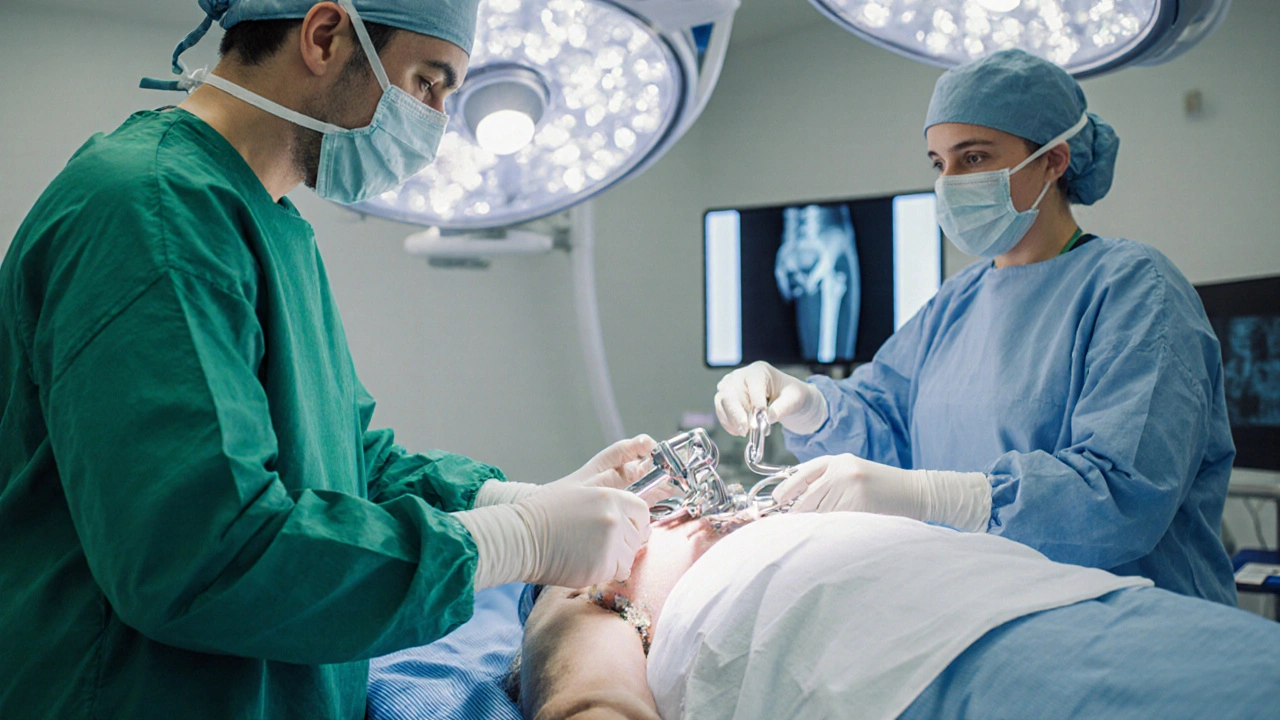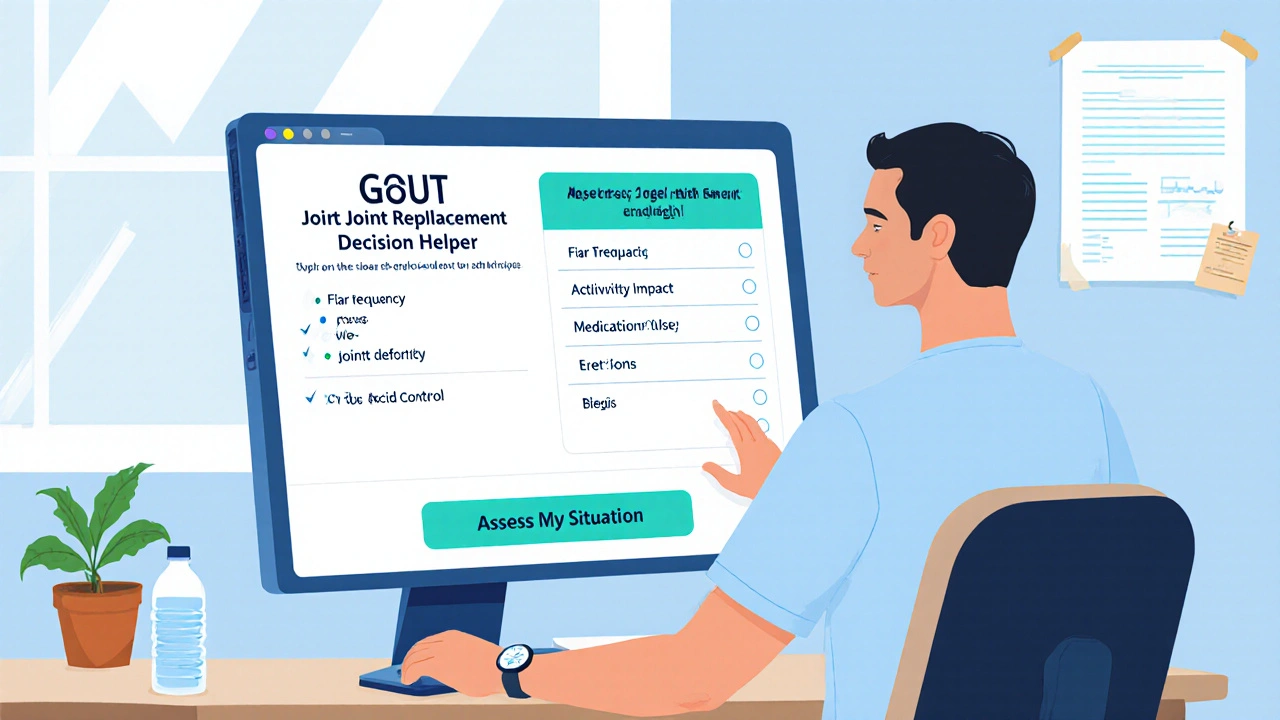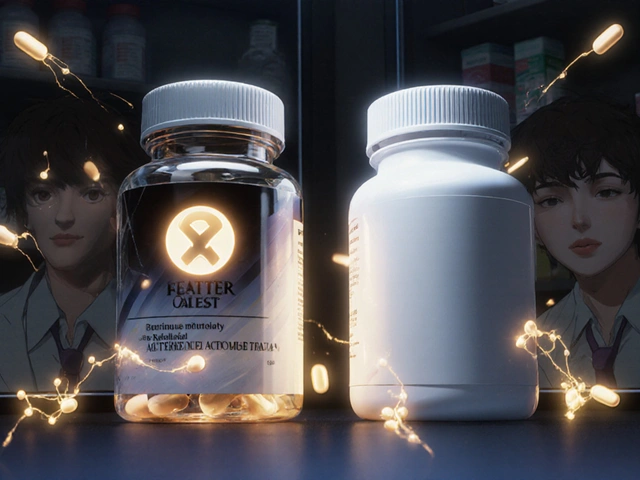Gout Joint Replacement Decision Helper
Answer the following questions to get guidance on whether joint replacement might be appropriate for your gout-related joint damage.
Your assessment results will appear here after answering the questions above.
Quick Take
- Gouty arthritis can damage joints enough to need a joint replacement.
- Hip and knee are the most common sites for surgery in gout patients.
- Pre‑op planning focuses on controlling uric acid levels and coordinating rheumatology and orthopaedics.
- Hospital stay is usually 2‑4 days; full rehab takes 3‑6 months.
- Long‑term success hinges on medication adherence, diet, and guided physiotherapy.
Understanding Gouty Arthritis
Gouty arthritis is a form of inflammatory arthritis caused by the accumulation of uric acid crystals in the synovial fluid of joints, triggering sudden, excruciating pain, swelling, and redness. It most often strikes the big toe, but chronic attacks can spread to the ankles, knees, hips, and elbows. Over time, the crystal deposits erode cartilage and bone, leaving the joint stiff and deformed. While lifestyle changes and urate‑lowering drugs can halt progression, some patients eventually need surgery to restore function.
Key triggers include high‑purine foods, alcohol, dehydration, and certain medications. The hallmark laboratory finding is serum uric acid above 6.8mg/dL, and joint aspiration will reveal needle‑shaped monosodium urate crystals under polarized light microscopy.
When Surgery Becomes an Option
Deciding on surgery is never taken lightly. An orthopaedic surgeon and a rheumatologist work together to evaluate:
- Degree of joint destruction on X‑ray or MRI.
- Frequency and severity of gout flares.
- Response to urate‑lowering therapy (allopurinol, febuxostat, or pegloticase).
- Overall health, including heart, lung, and kidney function.
Types of Joint Replacement for Gout Patients
The two most common procedures are hip and knee replacements. Both replace the damaged bone and cartilage with prosthetic components, but the surgical approach and post‑op protocols differ slightly.
Hip replacement involves removing the femoral head and acetabular socket, then inserting a metal‑on‑plastic or ceramic‑on‑ceramic bearing. The incision is typically 8‑12cm, and many surgeons now use a minimally invasive anterior approach to spare muscles.
Knee replacement (total knee arthroplasty) replaces the distal femur, proximal tibia, and often the patellar surface with metal and polyethylene components. Surgeons may choose a cruciate‑retaining or posterior‑stabilised design depending on ligament integrity.
Preparing for Surgery
Preparation starts months before the operation:
- Control uric acid levels. Aim for serum uric acid < 5mg/dL for at least six weeks. Your rheumatologist may adjust allopurinol dosage or add a short‑term colchicine bridge.
- Review medications. Aspirin, NSAIDs, and some anticoagulants increase bleeding risk and are usually stopped 5‑7 days prior.
- Optimise comorbidities. Diabetes, hypertension, and chronic kidney disease should be well‑controlled to lower infection risk.
- Pre‑op imaging. Standard AP and lateral X‑rays confirm component size; CT may be ordered if severe deformity exists.
- Physical conditioning. Light cardio, quad‑strengthening, and flexibility exercises improve post‑op mobility.
During the pre‑op visit you’ll meet two key specialists:
Rheumatologist oversees gout management, ensuring crystal burden is minimal before cutting into the joint.
Orthopedic surgeon explains the surgical technique, prosthetic options, and expected outcomes.

What Happens During the Operation
Modern joint replacement is usually performed under spinal or general anaesthesia and lasts 90‑120minutes. The steps are:
- Incision and exposure. The surgeon opens the joint capsule while protecting surrounding muscles and nerves.
- Removal of damaged bone. Specialized saws and rasps excise the arthritic surfaces.
- Trial components. Temporary prosthetic pieces are placed to assess fit, leg length, and range of motion.
- Implant placement. Cemented or cement‑less stems are inserted; cementless designs rely on bone growth for long‑term stability.
- Soft‑tissue balancing. Ligaments are tensioned to achieve a stable, pain‑free joint.
- Closure. The capsule and skin are sutured, and a drain may be left for a few hours.
Because gouty tissue can be inflamed and friable, surgeons often use gentle retractors and may give a single intra‑operative dose of steroids to blunt the inflammatory response.
Recovery Timeline and Post‑operative Rehabilitation
After surgery you’ll move to a recovery room, then a short stay on the orthopaedic ward.
Day 0‑1: Pain is managed with a multimodal regimen-regional nerve block, low‑dose opioids, and NSAIDs (if kidney function allows). Early ambulation with a walker begins within 6‑12hours.
Day 2‑4: Physical therapist guides gentle hip/knee flexion, quadriceps sets, and ankle pumps. Most patients are discharged home by day three.
Weeks 2‑6: Outpatient PT focuses on gait training, strengthening, and range‑of‑motion milestones. Gout patients should continue urate‑lowering drugs throughout rehab.
Months 3‑6: Full weight‑bearing activities, low‑impact sports (swimming, cycling), and gradual return to work. Implant survival rates exceed 95% at ten years when serum uric acid remains controlled.
Post‑operative rehabilitation is a collaborative effort between the physiotherapist, orthopaedic team, and the patient’s rheumatologist to keep inflammation in check while rebuilding muscle strength.
Managing Pain, Gout Flares, and Long‑term Care
Even after a flawless surgery, gout doesn’t disappear. To protect the new joint:
- Maintain serum uric acid < 5mg/dL. Periodic blood tests every 3‑6 months are standard.
- Continue prophylactic colchicine or low‑dose steroids during the first 6 weeks post‑op, especially if you had frequent pre‑op flares.
- Stay hydrated (≥2L water daily) and limit high‑purine foods such as red meat, shellfish, and organ meats.
- Use ice packs on the joint for 15‑20minutes after PT sessions to reduce swelling.
Should a flare occur after the prosthesis is in place, treatment is similar to pre‑op management-NSAIDs (if renal function permits), colchicine, or a brief steroid burst-but always coordinate with the orthopaedic surgeon to rule out infection.
Risks Specific to Gouty Patients
All surgeries carry risk, but gout adds a few extra considerations:
| Risk Factor | Hip Replacement | Knee Replacement |
|---|---|---|
| Infection | 1.5% (slightly higher if uric acid uncontrolled) | 2.0% (increased with repeated gouty attacks) |
| Implant Loosening (5‑yr) | 0.8% | 1.2% |
| Peri‑operative Flare | 15% (manage with pre‑op colchicine) | 20% (knee stress may trigger more crystals) |
| Venous Thromboembolism | 0.6% | 0.9% |
Overall, the benefits of restored mobility and pain relief far outweigh these modest risks when uric acid is well‑controlled.
Bottom Line: Making the Decision
If gout has left a joint fused, deformed, or constantly painful, joint replacement can give you a new lease on life. The key to success lies in a coordinated care plan: keep uric acid low, optimise overall health, follow the surgeon’s rehab protocol, and stay vigilant for any flare‑ups.
Remember, surgery isn’t a cure for gout-it’s a solution for the damage the disease caused. Ongoing medication and lifestyle habits keep that damage from happening again.
Frequently Asked Questions
Can I have joint replacement if my uric acid is still high?
Most surgeons prefer the level to be below 5mg/dL for at least six weeks before operating. If you’re above that, the team will intensify urate‑lowering therapy and may delay surgery until the level stabilises.
Will gout attacks stop after the new joint is in place?
The prosthetic joint itself isn’t affected by uric acid, but you can still get flares in other joints. Ongoing medication and diet are essential to prevent future attacks.
How long does the implant last for a gout patient?
When uric acid is controlled, modern implants have a 90‑plus‑percent chance of lasting 15‑20 years. Poor control can accelerate loosening due to crystal‑induced inflammation.
Is a cemented or cement‑less prosthesis better for gout?
Both work well; the choice depends on bone quality. Cementless stems rely on bone ingrowth, which can be compromised if chronic inflammation has thinned the cortex. In such cases, a cemented component offers more immediate stability.
What activities should I avoid after surgery?
High‑impact sports (running, basketball) should be delayed for at least six months. Low‑impact options like swimming, elliptical, and cycling are safe earlier, once your surgeon clears you.






Reviews
Wow! This guide is super helpful!!! I love how clearly it breaks down each step!!!
Dear readers, the comprehensive nature of this exposition on gouty arthritis joint replacement reflects a commendable synthesis of clinical insight and patient‑centred guidance. One might appreciate the meticulous attention to pre‑operative optimisation, postoperative rehabilitation, and the nuanced discussion of prosthetic longevity. 😊🌟
Gouty arthritis represents a metabolic disorder characterised by monosodium urate crystal deposition. Chronic crystal accumulation leads to progressive cartilage erosion and subchondral bone damage. When conservative measures fail, joint arthroplasty becomes a viable therapeutic option. The decision matrix includes flare frequency, functional limitation, urate‑lowering efficacy, and comorbid status. Imaging modalities such as plain radiography and magnetic resonance imaging delineate the extent of osteolysis and deformity. Serum uric acid targets below five milligrams per deciliter are associated with reduced peri‑operative complications. Orthopedic surgeons often coordinate with rheumatologists to synchronize medication adjustments. Pre‑operative cessation of NSAIDs and anticoagulants mitigates bleeding risk. Intra‑operative strategies may involve low‑dose corticosteroids to attenuate crystal‑mediated inflammation. Cemented versus cementless fixation depends on bone quality and surgeon preference. Post‑operative protocols emphasize early mobilisation, quadriceps activation, and weight‑bearing progression. Physical therapy regimens should be tailored to individual tolerance and joint biomechanics. Long‑term prosthetic survival exceeds ninety percent at fifteen years when metabolic control is maintained. Recurrence of gout flares in non‑prosthetic joints necessitates ongoing urate‑lowering therapy. Patient education regarding diet, hydration, and medication adherence remains paramount. Ultimately, multidisciplinary care optimises functional outcomes and quality of life.
It’s evident that most patients underestimate the importance of maintaining a low uric acid level; indeed, the literature definitly shows a correlation between uncontrolled gout and accelerated prosthetic loosening. While the surgical technique is refined, the real challenge lies in patient compliance-many ignore dietary recommendations and think medication alone will fix everything. That attitude is both short‑sighted and dangerous, especially considering the risk of infection in an inflamed joint. So remember, you cant just rely on the surgeon, you have to do your part.
Hey everyone! If you’re on the fence about surgery, think about the massive boost in mobility you can regain. A well‑planned hip or knee replacement can get you back to hiking, dancing, or simply walking to the mailbox without wincing. Just keep that uric acid in check and stick with the rehab schedule-no shortcuts!
One must consider the hidden agenda behind the proliferation of joint replacement procedures; pharmaceutical and device companies have a vested interest in promoting surgical interventions irrespective of patient necessity. The literature is often biased, and the long‑term data for gout patients remains insufficiently scrutinised. Therefore, a cautious approach, seeking second opinions and demanding transparent data, is advisable.
Seriously, who needs a new joint when you can just live with the pain?? It's all a cOn.
While the article paints a rosy picture of joint replacement for gout sufferers, it conveniently glosses over the potential for chronic implant failure due to ongoing crystal deposition. The notion that controlling uric acid alone will safeguard the prosthesis is overly optimistic. In reality, many patients experience recurrent flares that can compromise the surrounding soft tissue and bone integration. Additionally, the financial incentives tied to orthopedic implants raise questions about the impartiality of the recommendations. One should also weigh the psychological impact of living with a foreign object in the body, which is often dismissed in clinical narratives. The rehab timeline, though presented as a straightforward six‑month journey, can be fraught with setbacks, especially for individuals with concurrent comorbidities. Moreover, the risk of infection, even if statistically low, carries devastating consequences in this population. Thus, before committing to irreversible surgery, a thorough evaluation of alternative modalities, including emerging biologic therapies and lifestyle interventions, is paramount. Ultimately, the decision should be patient‑driven, free from external pressures, and grounded in a realistic appraisal of both benefits and risks.
Thanks for sharing this detailed guide 😊 I appreciate the balanced view and the emphasis on multidisciplinary care. It helped clarify many of my doubts about the pre‑op preparations and post‑op expectations. Feel free to let me know if you need any additional resources 🙏
THIS IS EXACTLY WHAT THEY WANT YOU TO THINK!!! THE HOSPITALS, THE PHARMA, THE SURGEONS-ALL PLAYING TOGETHER!!! DON'T BE FOOLED BY SMILEY FACES!!!
Can't wait to get back on my feet!!!
While the comprehensive overview is valuable, I'd add that patients should also monitor renal function closely when on allopurinol, as dose adjustments may be required to avoid toxicity.
The silence in the recovery room tells a story louder than any textbook ever could.
Great stuff! I think the key is staying consistent with meds & diet :) just dont forget the water.